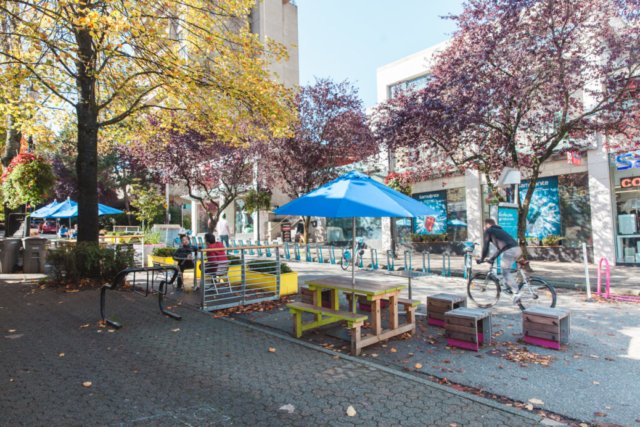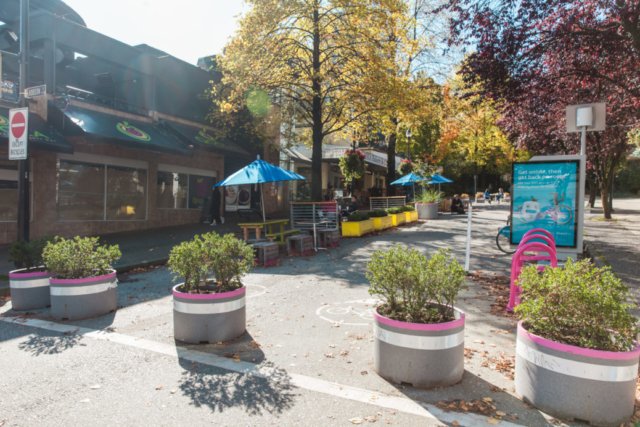Walkable Spanish streets show what’s possible for North America
Warm and cozy street life on this pedestrian avenue in Logroño, Spain. (Isabel Garcia)
What makes a great street?
As we explored in a previous story, math and rigid rules aren’t enough to build great cities. It’s easy to know a great street when you’re walking on it, but it can be more difficult to identify what elements make that street great.
By observing and learning from each other, we can design places that work better for everyone. Cities around the world can each offer unique lessons about building great, walkable environments. Here, we break down some of the essential elements, drawing inspiration from a few great Spanish streets.
Observing walkability from Spain to Vancouver
I'm Isabel Garcia, an enthusiast about walking as a healthy means of transportation. I was an airport engineer in Spain, but life circumstances brought me to Vancouver five years ago. Since then, I switched my career to promote walkable cities, both at Happy Cities and as the Living Streets program manager at BEST.
When I arrived in Canada, I became a full-time mom and caregiver for my baby. I couldn’t afford daycare, and didn’t have a support network to help me with childcare. I also don't have a driver’s license. So, each day, I put my baby in the stroller, setting out on foot to get groceries, visit community centres, and access shops and services.
Often, I found myself on busy main streets, where I struggled to hear my child over the engine sounds. It can feel like these loud, impersonal environments are designed to isolate us, pushing people to get to their destination as fast as possible. As a newcomer, I started to understand why Vancouver can have a reputation for being a lonely city.
The intersection of Main Street and 2nd Avenue in Vancouver. Wide streets and fast-moving cars dominate the street, making it an uncomfortable walking experience for people. (Isabel Garcia)
So began my career change to promote walkable and accessible cities. Naturally, on my many walks through Vancouver, I started to miss home, and the dense but human-scaled town centres that characterize many Spanish cities. In my work, I draw inspiration from some of the great streets of cities like Segovia and Logroño, two leaders in pedestrian-friendly design. Here are some of my favourites.
Streets designed for people
When streets are designed for people, they are filled with warmer sounds—lively chatter, music, and joy. They connect people to their destinations, while facilitating spontaneous social interactions by encouraging people to linger in the public realm—whether to play, have a coffee, chat with passersby, or just observe the street life. They feel safe, and comfortable.
Calle Real, a pedestrianized street in Segovia, shows what a street designed for people might look like. Many elements work together to create an inviting and social environment, such as the balconies facing onto the street, the varied building styles and designs, and the mix of shops and restaurants at ground level—all of which work together to create “active” building edges. The building heights are proportional to the street width, meaning that they avoid towering over people and let natural light in, while still creating a sense of enclosure.
Calle Real, Segovia, during the day. (Happy Cities)
Streets that are appealing to the eye and engaging—lined with shops, restaurants, and other points of interest—can instantly stimulate the brain, increasing positive feelings and happiness among those who travel through them. Happy Cities built on this research through a study in Seattle, finding that people walking along these “active” street edges are more helpful to and trusting of strangers, compared to those on inactive ones (think, blank concrete walls, no doors or windows, and no shops or services).
Thanks to a mix of restaurants, adequate lighting, and placemaking elements, Calle Real is equally lively at night, with colourful string lights overhead creating a sense of place and brightening up the winter nights. People travel along the street from morning to night, to go shopping, meet friends, eat, or just take an evening stroll.
Calle Real, Segovia, at night. (Happy Cities)
Car-free streets can also incorporate weather protection, and allow restaurant patios to spill comfortably onto streets, creating a comfortable environment to eat and socialize—no matter the season. While curbside patios have taken off in North America since the pandemic, in many cities, a number of patios still face onto busy, car-dominated streets, which can be loud and uncomfortable.
Parking spot patios on Main Street, Vancouver. (Google Street View)
By contrast, this pedestrian street in downtown Logroño feels much cozier, safer, and more inviting:
Downtown Logroño, Spain. (Happy Cities)
It’s not just about car-free streets
Even streets that still allow cars can be designed to make the experience of walking or rolling more enjoyable. Take this residential street in Logroño, for example. Planter boxes line the wide sidewalks and double as seating for people to rest and socialize. With the speed limit at 20 kilometres per hour, it’s quiet and comfortable to walk on. The design ensures that vehicles travel slowly, by alternating parking from one side of the street to the other so that traffic must follow a gentle curve in the road.
Mixed-use residential street, Logroño, Spain. (Happy Cities)
Mixed-use residential street, Logroño, Spain. (Happy Cities)
Maintaining essential traffic circulation
Sometimes, we still need cars—whether for local residents, people with mobility challenges, essential delivery vehicles, and emergency services. But there are ways to limit this essential car circulation, so that streets still feel safe and comfortable to walk on.
To preserve the pedestrian-priority area on Avenida del Acueducto, another one of Segovia’s car-free streets, the City allows for commercial traffic and deliveries to the businesses until 10 o’clock in the morning, when the shops open. In turn, waste collection happens at night, ensuring that people can enjoy strolling through and lingering on the street during the day.
Segovia's pedestrian area at night. (Isabel Garcia)
Many Spanish cities also use automatic license plate scanners to limit car circulation to local residents or tourism business only, like hotels and taxis. These sensors scan vehicles and automatically lower bollards if a vehicle has permission to drive through. In the photo below, the white car has just passed through, so the bollard in the middle of the street has been temporarily lowered.
Santo Domingo de la Calzada, a small village located along the Camino de Santiago, uses license plate scanners to restrict car circulation to local residents. (Isabel Garcia)
Logroño similarly restricts vehicle access to the downtown area by license plate, only allowing residents or designated vehicles to enter. (Isabel Garcia)
Bollards that can automatically lower are also important for allowing emergency vehicle circulation through otherwise pedestrian-only areas. For example, in Segovia, emergency vehicles can drive onto the pedestrian areas as needed. The sirens on these cars don’t need to be as loud as on busy, car-dominated roads, adjusting their noise levels for the human ear.
People make way for an emergency vehicle along a pedestrian street in Segovia. (Isabel Garcia)
A central community heart
Despite what it may seem, some public spaces in Segovia weren’t always car-free. Segovia’s pedestrian streets are connected to a large public square, Plaza del Azoguejo. The plaza is centuries old, distinguished by a Roman aqueduct that carried water into the city until the 1970s. When cars became a popular mode of travel, they used to pass under the aqueduct’s arches, compromising the structure because of fumes and vibration. In 1992, the City dictated a drastic measure, banning cars and returning the space to people for walking, resting, and socializing. Although the decision was controversial at the time, the success is evident: locals and tourists alike visit the square daily, at all hours, year-round.
Plaza del Azoguejo in Segovia is connected to several pedestrian streets, creating a central community heart. (Isabel Garcia)
Drawing inspiration from great places
Like any city, Vancouver does many things well—but we’re still learning.
Over the past few years, we’ve seen small wins, from the adoption of a permanent parking spot patio program, to the transformation of several street blocks across the city into public spaces through the Pavement-to-Plaza program.
14th-Main Plaza (Alison Boulier)
Bute-Robson Plaza (Alison Boulier)
Bute-Robson Plaza (Alison Boulier)
The results of these street transformations speak for themselves. When cities allocate more street space to people, it contributes to greater trust, joy, and happiness. For example, in our study of the temporary patios that took off in Vancouver during the COVID-19 pandemic, we found that people sitting outside on the street were more likely to be engaged in conversation than those inside—and more likely to be laughing: Our study observed nearly 50 per cent of people on patios laughing, compared with only one third of those sitting inside.
The proof is in the people
If that evidence isn’t enough, we can look to great streets around the world—in Canada, Spain, and beyond—to see just how many people will flock to great public spaces and streets, once they are designed with people in mind.
If you create a wonderful street, people will use it. (Isabel Garcia)



















